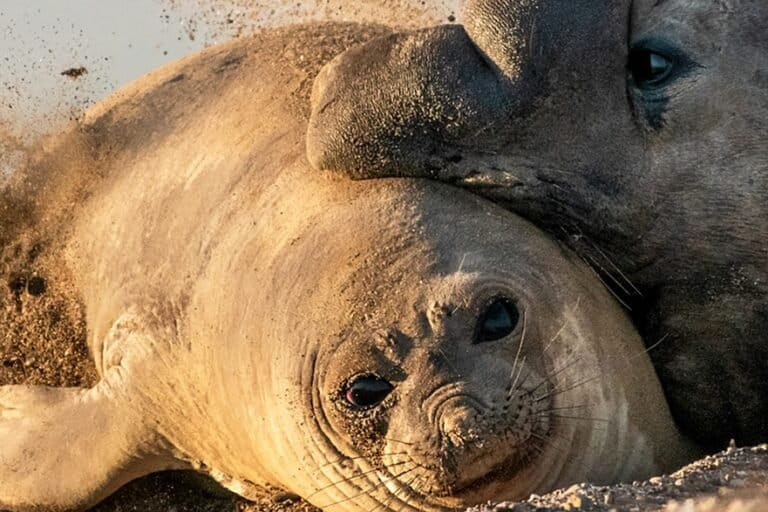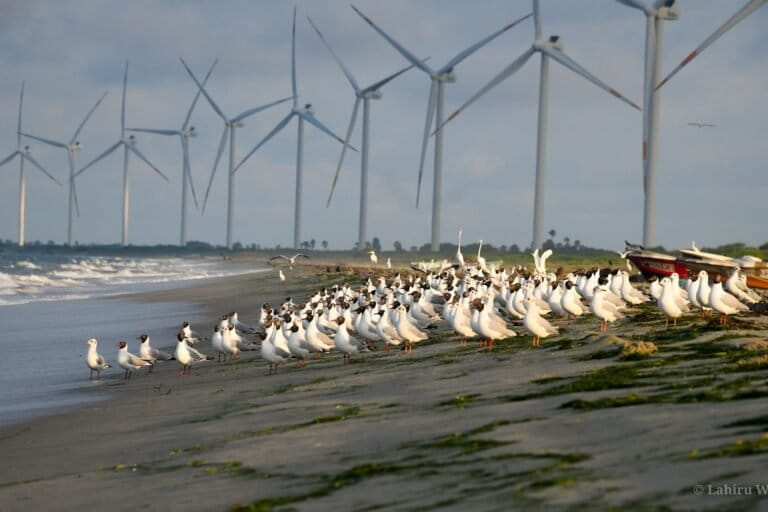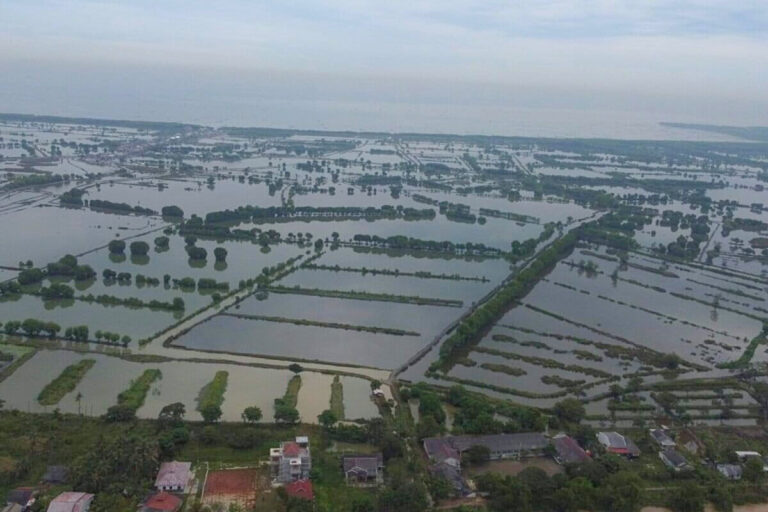- The Antarctic winter sea ice maximum is on track to be the second lowest on record, at 17.15 million square km² (6.62 million mi²), close to the 2023 record low of 16.96 million km² (6.55 million mi²). Some scientists see this as anomalous. Others see it as a shift in the southern polar environment, maybe triggered by climate change.
- The Arctic summer sea ice minimum also stayed low this year, at 4.28 million km² (1.65 million mi²), making it the 7th lowest minimum in the satellite record. So far, 2012 saw the record minimum of 3.41 million km² (1.32 million mi²).
- Polar sea ice losses have global impacts. In one analysis, researchers estimated the planetary cooling effects of Arctic and Antarctic sea ice during 2016-2023 were about 20% and 12% less, respectively, than they were during 1980-1988, leading to almost 15% less cooling power for the planet.
- With about 12% declines of Arctic Ocean ice each decade, researchers predict a nearly ice-free Arctic summer by 2050, allowing more shipping through the Northwest Passage but threatening this unique polar ecosystem. Studies also show the Antarctic ice sheet to be increasingly at risk, particularly Western Antarctica.
For sea ice scientists, September is the time for polar highs and lows. Around mid-month, the Antarctic winter sea ice approaches its highest extent, while the Arctic summer thaw melts the region’s sea ice to its lowest extent.
This year, Antarctic sea ice is shrinking to new winter lows for the second year in a row, with only 17.15 million km2 (6.62 million mi2) remaining on September 19, according to satellite records analyzed by the U.S. National Snow and Ice Data Center (NSIDC). This drop is almost one million km2 (roughly 400,000 mi2) less than the typical mid- September mean of about 18.5 million km2 (about 7.1 million mi2). But scientists say it may still be too soon to declare the winter sea ice annual maximum extent.
In the Arctic this year, sea ice continues its multidecade downward slide, with just 4.28 million km2 (1.65 million mi2), making it the 7th lowest minimum in the satellite record, based on the NSIDC 5-day average extent.
Polar researchers want to know: Is sea ice decline the new normal?
“That’s the big question,” said Walt Meier, a sea ice expert with the NSIDC. “Is the Antarctic sea ice finally responding to global warming? Or is this just an extreme year or two?”

Southern sea ice setting record winter lows
Historically, the sea ice that extends out from the edges of Antarctica has been far slower to respond to climate change than its northern counterpart. Unlike the Arctic, where global warming has heated up the region four times as much as anywhere else on the planet, the Antarctic is somewhat cocooned by circumpolar winds and ocean currents that keep the cold close to the southern continent and the heat farther away.
Although Antarctic sea ice extent dropped below the 1981-2010 average in 2023 and 2024, according to NSIDC data, the overall long-term melting trend is still pretty close to zero, Meier noted.
That’s why scientists were stunned when the 2023 winter sea ice maximum dropped to a recorded low of 16.96 million km2 (6.55 million mi2) on Sept. 10, 2023. An analysis published earlier this year suggests this marks the start of an Antarctic regime shift, but researchers are careful to point out this isn’t the same as a no-turning-back tipping point.
Other researchers say “it’s too early” to tell whether the recent declines mark the onset of a trend, or are merely environmental variability.
Polar opposite
In the far north, this year’s Arctic sea ice summer minimum extent was no surprise to scientists. Satellite records show sea ice has declined there by about 12% every decade since the NSIDC began annual satellite monitoring in 1979. The current minimum of 4.28 million km2 (1.65 million sq mi2) could potentially still go lower, according to NSIDC.
“This will make 18 years of one low after another,” Meier said, making these metrics almost a new normal. (Researchers point out that no new normal can truly be declared so long as carbon emissions continue rising, further warming Earth.)
Every year since 2007, when the northern sea ice dropped to 4.13 million km2 (1.59 million mi2) the annual summer minimums have been lower than any melt season before that, he said. “It’s really a remarkable shift from what it used to be in the ’80s and early ’90s,” Meier said. The Arctic is “a very different environment now.”
The 2012 low of 3.41 million km2 (1.32 million mi2) continues to be the record holder — attributed to the ice-shattering effect of an extremely strong August cyclone that summer. But researchers say it’s only a matter of time until sea ice minimums fall even lower.

How low can the sea ice go?
For many thousands of years, polar sea ice and snow has reflected back out into space solar radiation that would otherwise be absorbed by the dark seawater or land — causing the Arctic and Antarctic to act something like an “air conditioner” for the planet. Known as the albedo effect, this property influences weather patterns and ocean circulation, and sustains the biodiversity of unique polar ecosystems.
Scientists agree that continued sea ice loss will change all that. In one recent analysis, researchers estimated the planetary cooling effects of Arctic and Antarctic sea ice during 2016-2023 were about 20% and 12% less, respectively, than during 1980-1988, leading to almost 15% less cooling power for the planet.
The age of the sea ice is another concerning factor in this polar meltdown. Throughout the annual seasonal cycle, polar sea ice never completely melts away, and in the past much of its volume in the Arctic lingered to become the enduring base for fresh ice the following year. Compared to thinner, younger ice, this multiyear ice is more resistant to melting and better at reflecting away solar radiation.
Studies predict that an ice-free Arctic, defined as having less than 15% ice coverage, will likely occur during the summer melt season sometime before 2050. A blue Arctic, with less than one million km2 (about 400,000 mi2) of sea ice, would see just a bit of ice fringing Greenland and within the Canadian Archipelago, Meier said. The mostly exposed Arctic Ocean would absorb far more heat and light, affecting the entire ecosystem, with potentially dangerous climate impacts for the rest of the world.
Additionally, less Arctic sea ice could open up more shipping routes through the Northwest Passage, according to some modeling studies. A shorter, more efficient polar transit could be a boon to global commerce and remotely located communities. However, more vessels would also increase pollution — from vessel discharge, oil spills and excess sound — in areas where biodiversity is already challenged by the warming climate.
Other researchers point out that “ice-free” doesn’t equal open water. There will still be floating icebergs that could cause safety hazards for vessels traveling through key entry points into the Arctic Passage.
“In some ways it’s nice not to have these new record lows and see the ice [slowly] wither away,” Meier said about the annual metrics. “But it’s also another really low year that would have been shocking 20 years ago. And now it’s just kind of routine.”
Banner image: A group of chinstrap penguins on pack ice on Seal Island in Antarctica. Penguins are al-ready being seriously impacted by climate change in the Antarctic. Image courtesy of NOAA NMFS SWFSC Antarctic Marine Living Resources Program/Dr. Mike Goebel.
Polar warning: Warming temperatures mean more than melted ice
Citations:
Gilbert, E., & Holmes, C. (2024). 2023’s Antarctic sea ice extent is the lowest on record. Weather, 79(2), 46-61. doi:10.1002/wea.4518
Rantanen, M., Karpechko, A. Y., Lipponen, A., Nordling, K., Hyvärinen, O., Ruosteenoja, K., … Laaksonen, A. (2022). The Arctic has warmed nearly four times faster than the globe since 1979. Communications Earth & Environment, 3(1), 168. doi:10.1038/s43247-022-00498-3
Hobbs, W., Spence, P., Meyer, A., Schroeter, S., Fraser, A. D., Reid, P., … Boyd, P. W. (2024). Observational evidence for a regime shift in summer Antarctic sea ice. Journal of Climate, 37(7), 2263-2275. doi:10.1175/jcli-d-23-0479.1
Zhang, J., Lindsay, R., Schweiger, A., & Steele, M. (2013). The impact of an intense summer cyclone on 2012 Arctic sea ice retreat. Geophysical Research Letters, 40(4), 720-726. doi:10.1002/grl.50190
Duspayev, A., Flanner, M. G., & Riihelä, A. (2024). Earth’s sea ice radiative effect from 1980 to 2023. Geophysical Research Letters, 51(14). doi:10.1029/2024gl109608
Jahn, A., Holland, M. M., & Kay, J. E. (2024). Projections of an ice-free Arctic Ocean. Nature Reviews Earth & Environment, 5(3), 164-176. doi:10.1038/s43017-023-00515-9
Mahmoud, M. R., Roushdi, M., & Aboelkhear, M. (2024). Potential benefits of climate change on navigation in the northern sea route by 2050. Scientific Reports, 14(1), 2771. doi:10.1038/s41598-024-53308-5
Cook, A. J., Dawson, J., Howell, S. E., Holloway, J. E., & Brady, M. (2024). Sea ice choke points reduce the length of the shipping season in the Northwest Passage. Communications Earth & Environment, 5(1). doi:10.1038/s43247-024-01477-6
FEEDBACK: Use this form to send a message to the author of this post. If you want to post a public comment, you can do that at the bottom of the page.


















